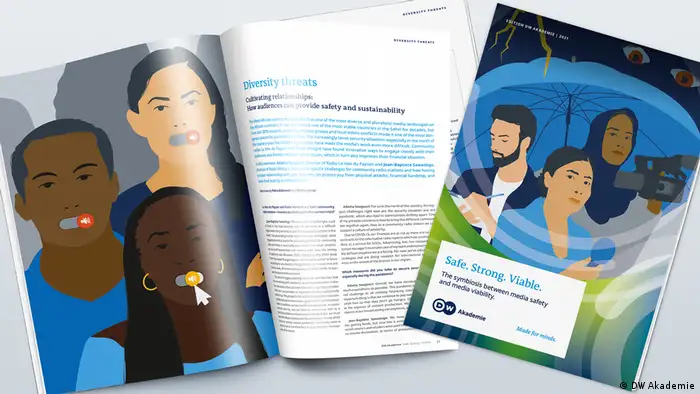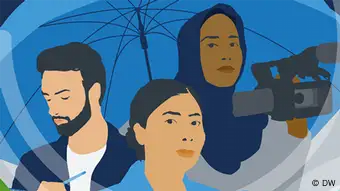Publications
Safe. Strong. Viable. - The symbiosis between Media Viability and Media Safety
Investing in safety and security measures not only saves lives but also strengthens the business models of media outlets. This paper focuses on the synergy of media safety and media viability.
At DW Akademie, we regard strong media organizations that produce quality content — whether commercial media, non-profit newsrooms or community media — as an essential pillar of democracy. This is why one of the focal areas of our work is media viability — the ability of media to produce high quality journalism in a sustainable way. Media outlets can play an essential role in sorting facts from fiction, offering a platform for diverse opinions and moderating discussions. Media outlets that report independently and provide people with reliable information are indispensable for any open society.
However, public interest media outlets have been under threat — not just from those who do not want a free, critical press but also economically, due to changes in the market that demand much more creative ways of generating income for a sustainable media business model. Internationally, there have been huge efforts to improve the safety of journalists and the legal frameworks in which media workers operate. But the more we at DW Akademie understand the different elements of media viability, the more we see the symbiosis between media safety and media viability.
Media safety has long been a concern around the world, with the number of journalists attacked, imprisoned or indeed killed at a constant high for decades. In addition, digital threats are increasing and media outlets have been struggling to find answers to digital challenges and changing user habits that are affecting the overall business model and hence labor security for many media workers.
And then came COVID-19: the pandemic and its effects on economic, social and political environments have created an alarming situation for media organizations in countries all over the world, with governments cracking down on freedom of expression and attacking those who report critically on government measures.
Reliable information is especially essential in crisis situations — as COVID-19 has shown — and media outlets carry the heavy responsibility of providing balanced news, exposing abuse of power and corruption, and countering disinformation. Paradoxically, crises make it especially difficult for media to provide their audiences with relevant and balanced information whilst keeping their employees safe and maintaining their financial stability. Media professionals are targeted, media freedom is restricted, (self-) censorship increases and income sources break away.
We asked journalists, media founders and managers from the Philippines, Mexico, Lebanon, and Burkina Faso this question: Do you see a direct link between producing quality content, engaging the audience and generating income from diverse sources, and the safety of your staff and media as a whole? Or alternatively: Do you believe that media outlets are more viable thanks to a holistic approach to safety and security, including digital and physical security, as well as ensuring that staff and freelancers have labor security?
Their answers do not only point to individual cases of threatened journalists but rather to a problem at the organizational level. They show that media houses and media organizations that think broadly about security issues from the beginning, establish a safety culture, relate closely to their audience, and provide high quality and balanced journalism are both more resilient and more protected against external attacks. Media outlets that understand the legal and economic environment they are operating in, that know their strengths and also their audience, and can set up and adapt their business model in a more flexible way, also have the best preconditions for staying viable. In this publication, experts in matters of newsroom safety, digital security and safety for women and minority groups provide the necessary context and give practical examples and advice.
The experiences shared in this publication clearly illustrate the connection between these viability aspects and how they mutually enhance one another — creating interdependence between the safety and security of journalists, access to information and freedom of expression for the general public.
Of course, training individual journalists to stay safe — online and offline — and ensuring that those who attack anyone defending freedom of expression and access to information are brought to justice, continue to be essential elements for journalism safety. Through examples in this publication, we want to add a new perspective to the discussion. Showing that there is no viability without safety, the aim is to convince more people — especially media owners and managers — to get on board so that we can find new approaches to this very complex problem that affects us all. Investing in safety and security measures — whether through safety training, safety protocols, advocacy for improved legal frameworks or digital security — not only saves lives but also strengthens the business ecosystem of a media outlet.
(2021-05-19) We apologize for the inconvenience but because of a technical problem, there could be an error when downloading PDFs. If you experience this, please email us and we will send you the document directly via email.
dw-akademie(at)dw.com
DW recommends
Downloads
- Date 26.05.2021
- Feedback: Send us your feedback.
- Print Print this page
- Permalink https://p.dw.com/p/3sZLg
- Date 26.05.2021
- Send us your feedback.
- Print Print this page
- Permalink https://p.dw.com/p/3sZLg


